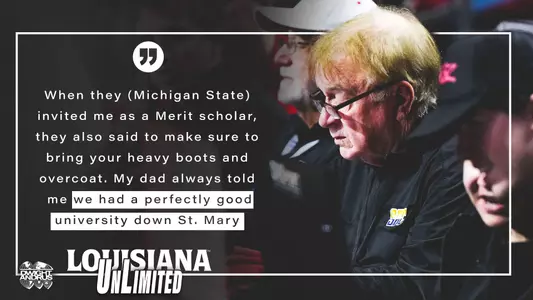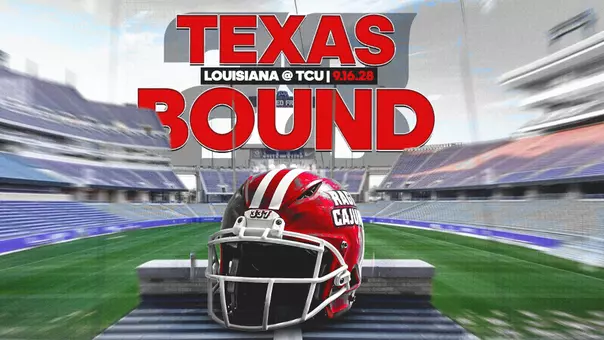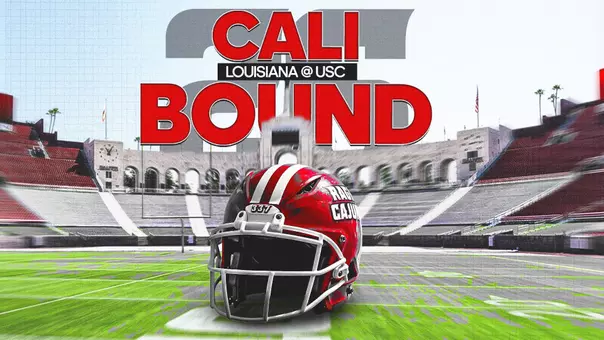University of Louisiana at Lafayette Athletics

Louisiana UnLimited: Lafayette's Own Ronnie Stutes
11/24/2023 9:06:00 AM | Football, Athletics, Louisiana UnLimited
Saturday's Cajun Field finale will be Stutes' 264th conesecutive game
He's been a part of Louisiana's football press box crew for 60 years, and he actually predates Cajun Field. His first game in an official capacity came on Sept. 28, 1963, at long-gone McNaspy Stadium, when the then-Bulldogs beat Hardin-Simmons ,16-6, in that season's home opener.
This Saturday, he'll work his 264th consecutive home football game, dating back to 1973, when the Ragin' Cajuns face ULM in the 2023 regular-season finale and in the final game of Cajun Field's current configuration.
But those aren't Ronnie Stutes' only unique numbers.
Try 18, which is the number of major film and TV credits he's logged, sharing time with actors like Robert Duvall and Margot Kidder as a card-carrying member of the Screen Actors Guild (SAG).
Or 45.5 million, which is the approximate number of times the Lil' Wayne video "Pop Bottles" has been downloaded and/or viewed over the past two decades. Ronnie's in that, too.
Or perhaps 1-A, which is what he was classified by his local military draft board in 1968 before he dodged the draft … well, sort of, and only for one year.
Numbers have been important in all of his 76 years. So when someone thinks the football's on the 36-yard-line and Ronnie says it's on the 37 … well, that other guy's just wrong.
"Ronnie is the most meticulous person I know," said Guy Rials, one of his cohorts in the Cajun press box and courtside crew for most of those 60 years. "I'm not overstating that. He's meticulous to a fault. It drives us crazy at times, but his number one goal in whatever he's doing at a game is to get the numbers right."
That's what Stutes has done ever since legendary sports information director Bob Henderson recruited him in the fall of 1963 along with two other local high school students. Their job? Keep the statistics for the USL football team to free up Henderson to take care of his myriad other duties.
"Max Hohenberger and I were juniors at Lafayette High," Stutes said. "I was 15 years old and stood 4'11", Max was a little older and a little shorter. Coach Rayford LeBlanc at Lafayette High had given us a letter addressed to Bob Henderson to make sure we could get into the press box for the high school jamborees where Lafayette High was playing.
"We took seats in the box and I propped up that letter at the base of the window with Mr. Henderson's name showing. During the game I heard a voice behind asking, 'Is that for me?,' and I looked back and saw a tall, very slender man, of course it was Bob.
"Some days later, when I arrived for sixth hour PE, Max told me that Mr. Henderson had called, saying he lost his prior statisticians and wanted us to work at USL."
At his first game, Stutes was the "spotter" and Max and Woody Lemaire, another Henderson recruit from Northside High, did the actual statistics. By the next game, Stutes moved into one of the recording roles. "I never went back to being a spotter," he said, adding that he received the princely sum of $2.50 for that spotting duty (the pay went all the way up to $5 the next week).
Later that year, he added basketball duties, and Henderson began recruiting Stutes to attend USL. The one problem – Stutes received a National Merit Scholarship in early 1965 to attend Michigan State and later an invitation to compete for MSU's Presidential Honor Award available only to the most outstanding among the Merit winners. How different would things have been if Stutes had headed to East Lansing, Mich., in his college days … and if the weather there had been more accommodating to a son of balmy South Louisiana.
"When they (MSU) invited me as a Merit scholar, they also said to make sure to bring your heavy boots and overcoat," Stutes said. "My dad always told me we had a perfectly good university down St. Mary."
Stutes had been a part of USL starting in 1955, attending elementary school on the campus starting in third grade, so those local ties won the day – not to mention Henderson's emphasis that USL was destined for a good 1965 season. He was right, the Bulldogs won the Gulf States Conference football title that year. Of course, Michigan State also won its Big 10 Conference title, and the national championship one year later.
After three years, Stutes had enough credits for his degree in mathematics, and the following year he was scheduled to be editor of USL's school paper The Vermilion, president of the USL Young Republicans and state president of the Baptist Student Union. But if he received that three-year degree, his student deferment from the draft would expire.
"I called the local draft board to make sure I could keep my deferment," he said, "and I was assured by the person on the phone if they couldn't continue my student deferment, they could give me another type of deferment for the fourth year. That was how I learned to get everything in writing."
Stutes got his first degree in May of 1968. One month later he was abruptly reclassified 1-A and ordered to report for a physical. Thanks to a lot of paperwork and appeals from Henderson and USL president Dr. Ray Authement, he extended that deferment, staying one more year in school and avoided the Army when he was accepted into the U.S. Air Force's officer training school.
By that time, he'd become the main cog in USL's game crew, not to mention all his other campus involvement.
"Ronnie was the director for intramural sports for the Baptist Student Union," Rials said, "and he had figured out exactly how many points everybody needed to score in the intramural track meet for us to win that meet and that year's intramural championship. He told me we'd win the meet if I finished second in the half-mile and third in the mile. What he didn't tell me was there were only two runners in the half-mile and three in the mile. All I had to do was not die.
"I believe everybody has a defining moment, and that's when I knew he was serious about statistics."
After being discharged from the Air Force, Stutes entered law school at LSU and inquired about a position in that school's game crew. He was told their crew was solid and had worked together for years. "Fine, I told myself, and I headed back to USL," he said. "I haven't missed a home football game since."
Stutes often worked around USL events and his legal duties, including a lot of hours with the Louisiana Legislature, to allow time for his acting passion. He had scenes in the highly-acclaimed "North and South" including a scene when he was a shotgun-toting barman helping a young Patrick Swayze run off Salem Jones and his cronies. He also had significant moments in Margot Kidder's film "Louisiana" in 1983 when he got his SAG card, and was featured in a national commercial – sort of.
"The good news is it was a national commercial," he said of his role as an auction bidder in a New Orleans auction house. "The bad news was the nation was The Netherlands." Still, it received extensive European play and Stutes was part of an 18-month contract for that shoot as part of SAG.
One of his favorite roles was with the crew of the highly-acclaimed "The Apostle," which earned director and star Robert Duvall an Academy Award nomination.
Stutes served as Duvall's stand-in and photo double. "I worked every day of that shoot," he said. "As a stand-in you're never in the movie, but as a photo double you're in the long shots. When it looks like Duvall's driving the church bus, it was me driving. I had a one-day speaking role there, too."
Stutes also found a way to tie that "Apostle" production into USL football, in time for the biggest home win in Ragin' Cajun history in 1996 – the 29-22 victory over Texas A&M's Aggies.
"I had invited Duvall to come to the game and told him they (USL) were playing Texas A&M," he said. "He and his future wife and the two producers came. He said, 'I bet Farrah would like to come, too.'" As in Farrah Fawcett.
Farrah didn't make the game, and nobody knows for certain if anyone else in that group helped tear the goal posts down post-game after that monumental win. For certain, Ronnie wasn't. He was too busy adding up the numbers.
"60 years … think about that," Rials said. "On Saturday, we're going to tell him that from this day forward, this press box will be known as the Ronnie Stutes Press Box."
Of course, with the impending demolition of Cajun Field's west side, the Ronnie Stutes Press Box will be a pile of rubble in a few weeks. No matter, it's the thought that counts.
This Saturday, he'll work his 264th consecutive home football game, dating back to 1973, when the Ragin' Cajuns face ULM in the 2023 regular-season finale and in the final game of Cajun Field's current configuration.
But those aren't Ronnie Stutes' only unique numbers.
Try 18, which is the number of major film and TV credits he's logged, sharing time with actors like Robert Duvall and Margot Kidder as a card-carrying member of the Screen Actors Guild (SAG).
Or 45.5 million, which is the approximate number of times the Lil' Wayne video "Pop Bottles" has been downloaded and/or viewed over the past two decades. Ronnie's in that, too.
Or perhaps 1-A, which is what he was classified by his local military draft board in 1968 before he dodged the draft … well, sort of, and only for one year.
Numbers have been important in all of his 76 years. So when someone thinks the football's on the 36-yard-line and Ronnie says it's on the 37 … well, that other guy's just wrong.
"Ronnie is the most meticulous person I know," said Guy Rials, one of his cohorts in the Cajun press box and courtside crew for most of those 60 years. "I'm not overstating that. He's meticulous to a fault. It drives us crazy at times, but his number one goal in whatever he's doing at a game is to get the numbers right."
That's what Stutes has done ever since legendary sports information director Bob Henderson recruited him in the fall of 1963 along with two other local high school students. Their job? Keep the statistics for the USL football team to free up Henderson to take care of his myriad other duties.
"Max Hohenberger and I were juniors at Lafayette High," Stutes said. "I was 15 years old and stood 4'11", Max was a little older and a little shorter. Coach Rayford LeBlanc at Lafayette High had given us a letter addressed to Bob Henderson to make sure we could get into the press box for the high school jamborees where Lafayette High was playing.
"We took seats in the box and I propped up that letter at the base of the window with Mr. Henderson's name showing. During the game I heard a voice behind asking, 'Is that for me?,' and I looked back and saw a tall, very slender man, of course it was Bob.
"Some days later, when I arrived for sixth hour PE, Max told me that Mr. Henderson had called, saying he lost his prior statisticians and wanted us to work at USL."
At his first game, Stutes was the "spotter" and Max and Woody Lemaire, another Henderson recruit from Northside High, did the actual statistics. By the next game, Stutes moved into one of the recording roles. "I never went back to being a spotter," he said, adding that he received the princely sum of $2.50 for that spotting duty (the pay went all the way up to $5 the next week).
Later that year, he added basketball duties, and Henderson began recruiting Stutes to attend USL. The one problem – Stutes received a National Merit Scholarship in early 1965 to attend Michigan State and later an invitation to compete for MSU's Presidential Honor Award available only to the most outstanding among the Merit winners. How different would things have been if Stutes had headed to East Lansing, Mich., in his college days … and if the weather there had been more accommodating to a son of balmy South Louisiana.
"When they (MSU) invited me as a Merit scholar, they also said to make sure to bring your heavy boots and overcoat," Stutes said. "My dad always told me we had a perfectly good university down St. Mary."
Stutes had been a part of USL starting in 1955, attending elementary school on the campus starting in third grade, so those local ties won the day – not to mention Henderson's emphasis that USL was destined for a good 1965 season. He was right, the Bulldogs won the Gulf States Conference football title that year. Of course, Michigan State also won its Big 10 Conference title, and the national championship one year later.
After three years, Stutes had enough credits for his degree in mathematics, and the following year he was scheduled to be editor of USL's school paper The Vermilion, president of the USL Young Republicans and state president of the Baptist Student Union. But if he received that three-year degree, his student deferment from the draft would expire.
"I called the local draft board to make sure I could keep my deferment," he said, "and I was assured by the person on the phone if they couldn't continue my student deferment, they could give me another type of deferment for the fourth year. That was how I learned to get everything in writing."
Stutes got his first degree in May of 1968. One month later he was abruptly reclassified 1-A and ordered to report for a physical. Thanks to a lot of paperwork and appeals from Henderson and USL president Dr. Ray Authement, he extended that deferment, staying one more year in school and avoided the Army when he was accepted into the U.S. Air Force's officer training school.
By that time, he'd become the main cog in USL's game crew, not to mention all his other campus involvement.
"Ronnie was the director for intramural sports for the Baptist Student Union," Rials said, "and he had figured out exactly how many points everybody needed to score in the intramural track meet for us to win that meet and that year's intramural championship. He told me we'd win the meet if I finished second in the half-mile and third in the mile. What he didn't tell me was there were only two runners in the half-mile and three in the mile. All I had to do was not die.
"I believe everybody has a defining moment, and that's when I knew he was serious about statistics."
After being discharged from the Air Force, Stutes entered law school at LSU and inquired about a position in that school's game crew. He was told their crew was solid and had worked together for years. "Fine, I told myself, and I headed back to USL," he said. "I haven't missed a home football game since."
Stutes often worked around USL events and his legal duties, including a lot of hours with the Louisiana Legislature, to allow time for his acting passion. He had scenes in the highly-acclaimed "North and South" including a scene when he was a shotgun-toting barman helping a young Patrick Swayze run off Salem Jones and his cronies. He also had significant moments in Margot Kidder's film "Louisiana" in 1983 when he got his SAG card, and was featured in a national commercial – sort of.
"The good news is it was a national commercial," he said of his role as an auction bidder in a New Orleans auction house. "The bad news was the nation was The Netherlands." Still, it received extensive European play and Stutes was part of an 18-month contract for that shoot as part of SAG.
One of his favorite roles was with the crew of the highly-acclaimed "The Apostle," which earned director and star Robert Duvall an Academy Award nomination.
Stutes served as Duvall's stand-in and photo double. "I worked every day of that shoot," he said. "As a stand-in you're never in the movie, but as a photo double you're in the long shots. When it looks like Duvall's driving the church bus, it was me driving. I had a one-day speaking role there, too."
Stutes also found a way to tie that "Apostle" production into USL football, in time for the biggest home win in Ragin' Cajun history in 1996 – the 29-22 victory over Texas A&M's Aggies.
"I had invited Duvall to come to the game and told him they (USL) were playing Texas A&M," he said. "He and his future wife and the two producers came. He said, 'I bet Farrah would like to come, too.'" As in Farrah Fawcett.
Farrah didn't make the game, and nobody knows for certain if anyone else in that group helped tear the goal posts down post-game after that monumental win. For certain, Ronnie wasn't. He was too busy adding up the numbers.
"60 years … think about that," Rials said. "On Saturday, we're going to tell him that from this day forward, this press box will be known as the Ronnie Stutes Press Box."
Of course, with the impending demolition of Cajun Field's west side, the Ronnie Stutes Press Box will be a pile of rubble in a few weeks. No matter, it's the thought that counts.
Terrence Williams Media Availability (Dec 12 2025)
Friday, December 12
Tyree Skipper Media Availability (Dec 12, 2025)
Friday, December 12
Jim Salgado Media Availability (Dec 12, 2025)
Friday, December 12
Michael Desormeaux Media Availability (Dec 12, 2025)
Friday, December 12












